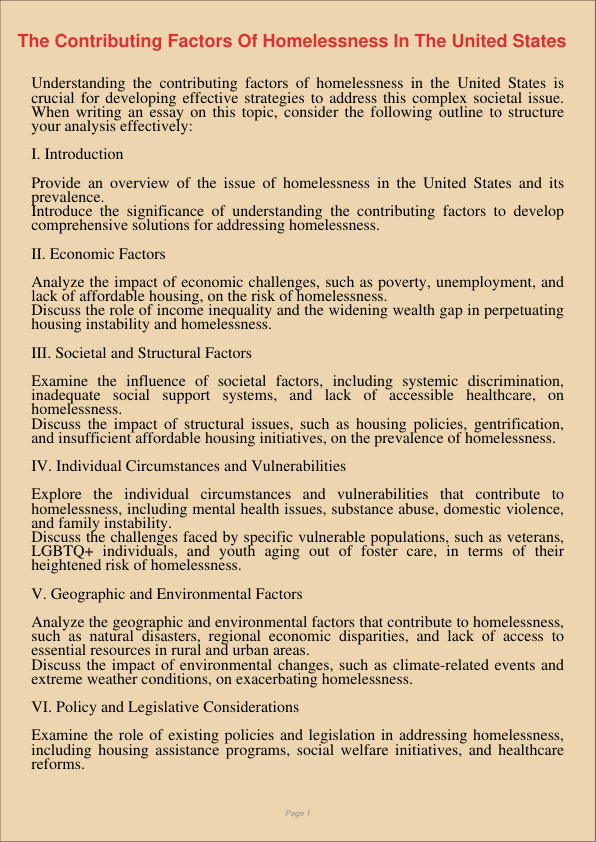The Contributing Factors Of Homelessness In The United States
Dec 31, 2023
united states
contributing factors
Visual Arts & Film Studies
Gender & Sexual Studies
Understanding the contributing factors of homelessness in the United States is crucial for developing effective strategies to address this complex societal issue. When writing an essay on this topic, consider the following outline to structure your analysis effectively:
I. Introduction
Provide an overview of the issue of homelessness in the United States and its prevalence. Introduce the significance of understanding the contributing factors to develop comprehensive solutions for addressing homelessness.
II. Economic Factors
Analyze the impact of economic challenges, such as poverty, unemployment, and lack of affordable housing, on the risk of homelessness. Discuss the role of income inequality and the widening wealth gap in perpetuating housing instability and homelessness.
III. Societal and Structural Factors
Examine the influence of societal factors, including systemic discrimination, inadequate social support systems, and lack of accessible healthcare, on homelessness. Discuss the impact of structural issues, such as housing policies, gentrification, and insufficient affordable housing initiatives, on the prevalence of homelessness.
IV. Individual Circumstances and Vulnerabilities
Explore the individual circumstances and vulnerabilities that contribute to homelessness, including mental health issues, substance abuse, domestic violence, and family instability. Discuss the challenges faced by specific vulnerable populations, such as veterans, LGBTQ+ individuals, and youth aging out of foster care, in terms of their heightened risk of homelessness.
V. Geographic and Environmental Factors
Analyze the geographic and environmental factors that contribute to homelessness, such as natural disasters, regional economic disparities, and lack of access to essential resources in rural and urban areas. Discuss the impact of environmental changes, such as climate-related events and extreme weather conditions, on exacerbating homelessness.
VI. Policy and Legislative Considerations
Examine the role of existing policies and legislation in addressing homelessness, including housing assistance programs, social welfare initiatives, and healthcare reforms. Discuss the implications of policy gaps and inadequate funding for homelessness prevention and support services at the federal, state, and local levels.
VII. Homelessness Prevention and Intervention Strategies
Propose effective prevention and intervention strategies, including affordable housing initiatives, comprehensive healthcare services, and supportive housing programs. Discuss the importance of implementing trauma-informed care, mental health support, and employment assistance to facilitate stable housing for individuals experiencing homelessness.
VIII. Community Engagement and Collaboration
Highlight the significance of community engagement, grassroots advocacy, and collaboration among governmental and non-profit organizations to address homelessness. Discuss the importance of fostering partnerships and building networks to promote holistic approaches to homelessness prevention and support.
IX. Conclusion
Summarize the key contributing factors of homelessness discussed in the essay, emphasizing the multifaceted nature of the issue. Advocate for a comprehensive, compassionate, and collaborative approach to addressing homelessness, focusing on the importance of structural changes, policy reforms, and community support to create sustainable solutions.
Ensure that your essay is supported by relevant data, statistics, and case studies to provide a comprehensive understanding of the contributing factors of homelessness in the United States. Additionally, emphasize the importance of prioritizing social justice, equity, and human dignity in efforts to address this critical societal issue.
